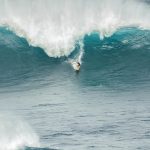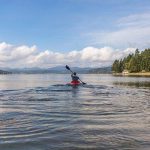If you’re a beginner looking to learn how to surf, you’re in for an exciting and rewarding experience.
However, surfing can be a challenging sport to master, especially if you’re new to it. That’s why we’ve put together this guide of essential beginner surfing tips to help you get started on the right foot.
From choosing the right surfboard to mastering the pop-up technique, we’ll cover everything you need to know to catch your first wave and progress in your surfing journey.
So, grab your wetsuit and let’s dive into the world of surfing!
Basic Surfing Tips For Beginners
It takes varying amounts of time to become a good surfer depending on many different factors. The action of coming up out of the water requires a particular amount of spinal suppleness and back strength.
Additionally, for efficient compression and decompression, your knees and hips should be reliable. The extent of your physical fitness and suppleness is an important factor in your acquisition of knowledge.
Primarily, a competent surf teacher will anticipate that their learners will possess an appropriate mental approach. If your mindset is not correct, you will either expend too much energy trying to perfect surfing techniques that are inappropriate for your current skill level (and make it harder for you to make progress later on) or give up before even attempting any tricks.
What is the right mental attitude? The ability to adapt to whatever the environment throws at you is a skill granted by Mother Nature. When it comes to surfacing, the conditions of the weather, water temperature, and type of waves that the beach breaks have are all out of one’s control.
You should acknowledge each thing as it occurs and remain tranquil when it presents itself.
Mastering the art of surfing requires you to leave behind your previous knowledge as you’ll encounter distinct types of surfboards that demand multiple physical and technical abilities while you journey through the stages of surfing.
If you do not possess the necessary mental fortitude and adaptability, you will find it hard to adjust.
Start on Beginner Surf Spots
After considering the standards we discussed earlier, we assume you are ready to evaluate your abilities in the water. But the question is, where do you go? Will the closest beach break just do? The response is a negative one. Oppositely, if you begin surfing in a location which is far from ideal for beginning surfers (such as reef breaks), you will find it hard to comprehend the basics and it will adversely affect your certainty in your skills.
A great place for a novice surfer to start is an area with shallow, smooth, and gentle waves. You will be taught how to paddle out and get caught up on a wave, how to get into the appropriate surfing stance, how to keep your balance as you ride, and how to gain momentum while riding the wave. You will be able to understand what kind of surfboard is best for you if the ocean waves are not extremely difficult.
Two methods to uncover surf locations suitable for beginners can be identified. Choose a beach that has a surf school. These schools tend to be located in areas with starting-level waves since they offer instructional courses for beginning surfers.
As you advance in your surfing, it is essential to have a good understanding of waves. Gaining an awareness of wave formation, tracking forecasts for surfing, and educating yourself on the ocean will be crucial components to gaining knowledge.
Know Your Equipment
A welder is not simply content to weld materials and remain silent. These are the people you should turn to when you want to buy a welding machine and have all the necessary information. Someone who rides motorcycles for a living is knowledgeable about the mechanics of bikes, the ideal tires for dirt trails, and the kind of helmet required for different atmospheric conditions. In the same way, a proficient surfer is one who is familiar with their gear.
Certainly, there is no need to completely immerse oneself in the world of surfing wear such as wetsuits and hats or gadgets like earplugs, but still, there must be a certain level of understanding before deciding to buy those items. Depending on the climate and the quality of the surf, you can make your shopping decisions.
However, these are really trivial pieces of equipment. It is essential for a surfer to be well-informed about surfboards, as this is clearly the most significant item of equipment for surfing.
Prior to taking to the water on a surfboard, it is essential to become familiar with the various shapes and what their optimal applications are. It is necessary to have some knowledge of the reason why particular boards are deemed well-suited for the novice, some for intermediate-level surfers, and some can be handled solely by the professionals.
Additionally, grasp the reasoning behind the establishment of the outlines of the different tails, rails, and noses, not to mention the criticality of the volume of your surfboard.
Perfect Your Pop-Up Technique on Land
When inexperienced surfers hear that they should be practicing surfing on land too, they usually don’t seem too pleased about it, however, surf-related activities on land are a major part of proper surf training. It is generally accepted that you should practice your pop-ups on land rather than in water, as this is how you fully master it.
Moreover, a pop-up is a necessary part of a ride since it sets the atmosphere for the entire experience.
The main factor in determining your stance when surfing is your pop-up. It should be balanced. If you don’t successfully get into the correct stance for surfing when you stand up, you may find yourself not having good balance on the board and shuffling your feet around to adjust.
No matter how sturdy the board may be, it will still move and become unsteady if large loads are transferred onto it. Consequently, you may experience a very bumpy experience or there may be no transportation available.
In order to avoid that consequence, you ought to rehearse popping up on your surfboard when it is on land. Here’s how:
- Position yourself in a way that’ll land you at the back of your board. It means your hands should be on the sides of the chest of the board and your feet hanging from the tail. If you put too much weight towards the nose, you’ll just nose dive.
- One of the greatest pieces of advice to give in surfing is to look where you’re going. It’s valid for pop-ups, too. Your eyes shouldn’t be fixed on the board but where you’re going. To that end, your back should be arched and your head tilted forward.
- Your feet need to face the same direction after your pop-up. Otherwise, your hips will start dancing on their own, and unstable hips are one of the main enemies of balance.
- Make sure your back is straight once you’re in a standing position. Even the slightest of leans will alter your center of gravity and throw you off balance.
- Your hands should be stable and point towards the direction of your ride. Otherwise, it’ll cause your board to wobble.
Choosing Your Board
For starters, you’ll need a board. Someone just starting out with surfing should use an 8-9 foot foam board. Soft tops with a larger size have greater volume relative to other kinds of surfboards. This book provides the surfboard with increased flotation, making it simpler to paddle and more secure to stay standing on.
An additional key factor to consider with soft tops is that they are pliable. If you’re just starting out, you will most likely trip and stumble quite a bit. It’s much more preferable to make contact with a softer surface than a harder one.
It is also more secure for anyone nearby should your surfboard accidentally collide with someone else’s (hopefully that never happens).
As a beginner, you may be inclined to purchase a fancy shortboard. Don’t do this. It is comparable to attempting to teach oneself skiing on the most advanced level of ski slope. You won’t have a good time. Shortboards have much less buoyancy than a longboard with a soft top, making them more difficult to paddle and less secure.
As a novice surfer, you won’t have enough power in your paddle or the ability to maintain balance to use a shortboard. If you begin with an appropriate board, you will become a better surfer much faster since you will have the ability to nab and stay upright on a higher number of waves.
Wetsuits
Depending on the beach that you are surfing at, you may need to invest in a wetsuit. If you’re in cold water, a wetsuit will greatly improve your comfort levels and will help you stay in the water for an extended period of time.
The type of wetsuit will depend on how cold the water is. If you’re surfing in water that is 75 degrees fahrenheit or warmer, you’ll be fine without one. For water that is 63-70 degrees, a 3/2 millimeter wetsuit is probably your best bet.
A 4/3 millimeter wetsuit is suitable for water that is in the 55-63 degree range. If the water is on the colder end of that range, you may want to add booties and/or a hood.
These are just the basics, and you should pick your wetsuit based on your own likes and dislikes. I typically ride the waves in temperatures ranging from 57 to 63 degrees, and I always use a 4/3mm thickness wetsuit with 2mm foot coverings.
Leashes
A leash attaches you to your board. It is advised that you should always secure your leash around the ankle of your rear leg. You need a leash as a beginner. Advanced surfers who use longboards can often be seen without a leash, as they are experienced enough to stay on the board or have assurance in their swimming ability to catch up to it if they do happen to fall off.
Using a leash when starting out is important to make sure your board does not drift away in the water. It will also stop your surfboard from colliding with other people in the water when it’s carried onto the shore. In general, the leash should be roughly the same size as your surfboard.
Where to Surf
Some beaches are suitable for novice swimmers, while other beaches may be more challenging. Look into it before venturing out to decide if the surf spot is appropriate for new surfers. If you are in an area where surfing is commonplace, you can ascertain this via an online search for something similar to “Top beginner surfing areas in ___.”
If you intend to surf in a place that is not well known for the activity, you may need to perform some research on your own. Examine the beach that you are looking into taking lessons at and remember some of its characteristics.
If you are only starting to learn how to surf, you should select a beach that has a soft sandy floor and waves with good shape and size. A beach with a lot of sand on it will be much more secure for you. When you fall, you will be safe from the threat of hitting any rocks or coral, which could be hazardous for inexperienced riders.
When you first go surfing, you will be maneuvering through the soft waves close to the shore. The suds that form as a result of a wave breaking are known as whitewater.
Studying in turbulent waters helps you hone in on the fundamentals – paddling and getting up. It is much simpler to capture whitewater than to attempt to ride a wave that is cresting. You’ll be able to take advantage of more chances to grab onto and bounce out of the swell in rapids.
It is simpler to gain access as you don’t have towork your way out by manoeuvring over turbulent waves, something that might be difficult to do when you are a novice. You should look for a beach with waves that are consistently around knee-high and have white foam.
Examine the other surfers present in the water. If the surfers right at the shoreline are all using shortboards and skillfully cutting through the waves, this may not be a beach that is suitable for those just starting to learn how to surf.
If you spot a few novices trying to accomplish a popping up on the turbulent waters, that’s a sign that the beach caters to those just starting out.
Have Fun
A key point for novice surfers to remember is that having the best time should be at the forefront of their surfing experience. This thought should be applied to each and every surf lesson and time spent in the water.
No doubt as you pursue your surfing, you’re bound to experience disappointment again and again, encounter instances when you’re overwhelmed by waves, doubt your own capabilities, and even end up with a few smashed (preferably inexpensive) surfboards.
But don’t let these things stop you from improving your skills, so don’t forget the pleasure that comes with surfing.
Naturally, in life, worries can come up about how to provide for oneself, how to communicate with other individuals and how to come to terms with the frightening workload of living.
Nevertheless, surfing is the perfect activity to take our minds off our worries and just enjoy ourselves. If surfing is causing you stress, it could be a sign that you need a break.
In short, though, surfing is and should be fun. It is essential that you always remember this, and that you never let it diminish in any way.
in conclusion
Learning to surf as a beginner can be both challenging and exhilarating. However, with the right mindset, practice, and guidance, you can progress quickly and confidently in this exciting sport.
By following the tips and techniques outlined in this guide, you’ll be well on your way to catching waves and carving up the surf in no time. Remember to be patient, stay safe, and most importantly, have fun!
With dedication and perseverance, you’ll soon be riding the waves like a pro. So grab your surfboard, hit the beach, and enjoy the ride!




